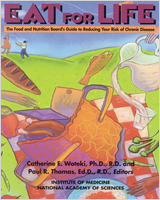NCBI Bookshelf. A service of the National Library of Medicine, National Institutes of Health.
Results from the National Research Council's (NRC) landmark study Diet and health are readily accessible to nonscientists in this friendly, easy-to-read guide.
Readers will find the heart of the book in the first chapter: the Food and Nutrition Board's nine-point dietary plan to reduce the risk of diet-related chronic illness. The nine points are presented as sensible guidelines that are easy to follow on a daily basis, without complicated measuring or calculating--and without sacrificing favorite foods.
Eat for Life gives practical recommendations on foods to eat and in a "how-to" section provides tips on shopping (how to read food labels), cooking (how to turn a high-fat dish into a low-fat one), and eating out (how to read a menu with nutrition in mind).
The volume explains what protein, fiber, cholesterol, and fats are and what foods contain them, and tells readers how to reduce their risk of chronic disease by modifying the types of food they eat. Each chronic disease is clearly defined, with information provided on its prevalence in the United States.
Written for everyone concerned about how they can influence their health by what they eat, Eat for Life offers potentially lifesaving information in an understandable and persuasive way.
Contents
- An Editorial Note
- Chapter 1. Introduction
- Chapter 2. Guidelines For A New Eating Pattern
- Chapter 3. The Food We Eat
- Chapter 4. Diet And Chronic Disease In The United States
- Chapter 5. Calories, Energy Balance, And Chronic Diseases
- Chapter 6. Fats, Cholesterol, And Chronic Diseases
- Chapter 7. Protein, Carbohydrates, And Chronic Diseases
- Chapter 8. Vitamins, Minerals, And Chronic Diseases
- Chapter 9. Alcohol, Other Food Substances, And Chronic Diseases
- Chapter 10. Making The Change To The New Eating Pattern
- Appendix A U.S. Recommended Daily Allowances
- Appendix B Resources
- Appendix C Committee On Diet And Health
The study summarized in this publication was supported by funds from the National Research Council Fund, the W.K. Kellogg Foundation, the Henry J. Kaiser Family Foundation, Pew Charitable Trusts, Fannie E. Rippel Foundation, and Occidental Petroleum Corporation. The Henry J. Kaiser Family Foundation supported the preparation of Eat for Life.
NOTICE: The project that is the subject of this report was approved by the Governing Board of the National Research Council, whose members are drawn from the councils of the National Academy of Sciences, the National Academy of Engineering, and the Institute of Medicine. The members of the committee responsible for the report were chosen for their special competences and with regard for appropriate balance.
This report has been reviewed by a group other than the authors according to procedures approved by a Report Review Committee consisting of members of the National Academy of Sciences, the National Academy of Engineering, and the Institute of Medicine.
The Institute of Medicine was chartered in 1970 by the National Academy of Sciences to enlist distinguished members of the appropriate professions in the examination of policy matters pertaining to the health of the public. In this, the Institute acts under both the Academy's 1863 congressional charter responsibility to be an adviser to the federal government and its own initiative in identifying issues of medical care, research, and education.
- NLM CatalogRelated NLM Catalog Entries
- Review [Simple obesity in children. A study on the role of nutritional factors].[Med Wieku Rozwoj. 2006]Review [Simple obesity in children. A study on the role of nutritional factors].Weker H. Med Wieku Rozwoj. 2006 Jan-Mar; 10(1):3-191.
- Review From dietary guidelines to daily food guide: the Taiwanese experience.[Asia Pac J Clin Nutr. 2008]Review From dietary guidelines to daily food guide: the Taiwanese experience.Tzeng MS. Asia Pac J Clin Nutr. 2008; 17 Suppl 1:59-62.
- Maximum Nutrition, Minimum Calories.[Obes Surg. 1992]Maximum Nutrition, Minimum Calories.Mallory G. Obes Surg. 1992 Nov; 2(4):375-378.
- Do dietary intakes affect search for nutrient information on food labels?[Soc Sci Med. 2004]Do dietary intakes affect search for nutrient information on food labels?Lin CT, Lee JY, Yen ST. Soc Sci Med. 2004 Nov; 59(9):1955-67.
- Developing actionable dietary guidance messages: dietary fat as a case study.[J Am Diet Assoc. 2001]Developing actionable dietary guidance messages: dietary fat as a case study.Borra S, Kelly L, Tuttle M, Neville K. J Am Diet Assoc. 2001 Jun; 101(6):678-84.
- Eat for LifeEat for Life
- Bent bone dysplasia syndrome 2Bent bone dysplasia syndrome 2MedGen
- C5774233[conceptid] (1)MedGen
Your browsing activity is empty.
Activity recording is turned off.
See more...
